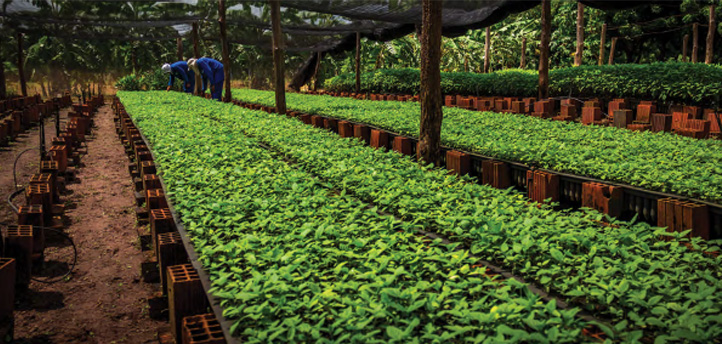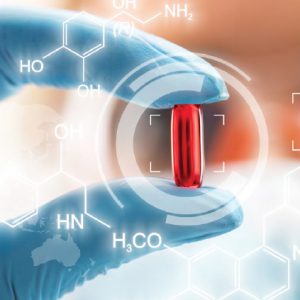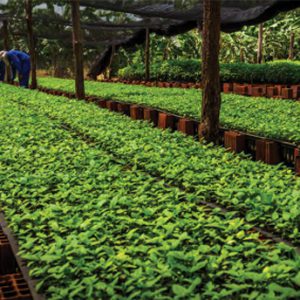A dvanced research studies carried out by international companies are promising to expand the market of pilocarpine, an Active Pharmaceutical Ingredient (API) whose raw-material – the jaborandi – is found mainly in Brazil. New uses of this API have been recently approved for the treatments of presbyopia (farsightedness), an ocular disorder affecting 1.8 billion people worldwide, and hyperhidrosis (excessive sweating). The Centroflora Group already provides 2/3 of the pilocarpine processed by pharmaceutic companies worldwide and is ready for the challenge of not only increasing the production but also of doing it in a sustainable way, in alignment with the ESG practices and values – good corporate practices in environmental, social, and governance areas.
Based on patented Technologies, innovations may double the global demand of this ingredient, currently 3 tons/year. The present production of pilocarpine at Centroflora supplies the demand for the manufacturing of medicines for its two pharmaceutical indications: glaucoma (increased intraocular pressure) and xerostomia (dry mouth).
Centroflora is able to supply the global market by means of a solid strategy as part of the Jaborandi Valorization Program, which includes community capacitation, development of an environmental consciousness, and live-forest management to revert the process of predatory exploitation of the plant. For more than 20 years, Centroflora collects Jaborandi leaves in a sustainable way in the Brazilian states of Piauí, Maranhão and Pará.
Besides forest management, the company has developed projects in Parnaíba (Piauí), where it cultivates the Jaborandi with huge investments in agrarian technology, aiming to expand the production of vegetal mass while protecting the environment. The plant guarantees the supply of this raw material and has been used in studies for new agrarian techniques. Moreover, Centroflora is now at the final stage of preparation of a 60-hectare jaborandi cultivated area.
SOCIAL TRANSFORMATION
The responsible activity of Centroflora in the Jaborandi chain will open a window of opportunities allowing economic returns not only to the company, but also to the gathering communities, as explained by the Group’s CEO, Peter Andersen.
“The demand for pilocarpine has been the same for the last 15 years, with a small reduction in the case of its use for glaucoma treatment (the original use of this API) and a small raise in the case of its use for xerostomia treatment, which has guaranteed the stability of benefits to the gathering communities. The potential use of pilocarpine for presbyopia and hyperidrosis treatments demands a significative raise of the production, with a positive impact for thousands of Brazilians who make their living from the sustainable collecting of jaborandi. In these communities, a long-term and steady income from jaborandi gathering is of fundamental importance and our efforts are going in this direction”, affirms Andersen.
Research works concerning the jaborandi started with a mapping of the areas with native jaborandi. The aim was the empowerment of the community starting from a reorganization of the productive chain, avoiding the presence of middlemen to allow better wages for local gathers.
About 30 thousand people are involved in the Jaborandi supply chain for Centroflora, and this number may be substantially increased, considering the rise of global demand for pilocarpine.
The Group develops training programs on proper plant management, informing the gathering community on the right plant size, the amount of leaves to be collected, the best time of the year for that and the preservation of seeds. Aspects of environment conservation are also approached, including waste treatment techniques and fire prevention. This capacitation program takes place along with daily operations of the chain, with the support of local partners.
Involved in a program for the benefit of their community, Jaborandi collectors report not only higher incomes and a better life quality, but also an increased self-esteem and a feeling of pride about their job with Jaborandi, an activity that used to be stigmatized.
ENVIRONMENT PRESERVATION
Education and training of collectors carried out by the Jaborandi Valorization Program also contribute in an effective way to the preservation of the environment by means of forest management techniques, avoiding the cutting of native vegetation and other aggressions to the ecosystem.
The model adopted by Centroflora represented a change of paradigm in relation to the old practice in which jaborandi was cut down. The plant was then included in the list of species in risk of extinction.
“Jaborandi gathering according to the Centroflora model has highly positive social impacts while valuing the forest”, says Priscylla Moro, the Partnerships Manager at Brazbio, a subsidiary of Centroflora for the implementation of sustainable arrangements in the natural and phytotherapy ingredients supply chain.
Forest management demands constant monitoring. That is carried out by means of a partnership between Brazbio and the Federal Rural University of Amazonia (UFRA, in Portuguese initials), who performs plant inventories and measures the true regeneration of the species in given areas. All this work is authorized by an annual permit issued by Chico Mendes Institute for Biodiversity Conservation (ICMBio), a legal body bound to the Ministry of Environment.
The Jaborandi Valorization Program has received acknowledgements for its importance: the First National Prize for Biodiversity, by the Ministry of Environment; its classification as a social technology, by the Banco do Brasil Foundation; and a mention as a Biodiversity Sustainable Use Business Initiative, by the National Industry Confederation (CNI, in Portuguese initials).
QUALITY OF THE INGREDIENT

The commitment of Grupo Centroflora includes the quality of the ingredient, from gathering fields to production plants. The biggest differential offered to pharmaceutic companies is the traceability of gathered leaves, an unprecedent practice in the Brazilian market. Centroflora counts on local partners to perform this task.
To mention a few examples, the Alto Xingu Small Farmers Alternative Mixed Cooperative (CAMPAX, in Portuguese initials) and the National Carajás Forest Gathers Cooperative (COEX, in Portuguese initials), in the state of Pará, have strong traceability of the leaves, with information on the respective areas of extraction per lot. In the state of Piauí, the settlement known as Cutia delivers information for each gatherer, total volumes, and the gathering area.
Besides, technical personnel in these cooperatives help with quality control measures, as they go on field to check how the work is carried out and to ensure the reproduction of the plant for the following year.
Quality guarantee at Grupo Centroflora is also a result of high-quality industrial manufacturing by a plant (CentroPhyto) in the state of Piauí, one of a few Brazilian API plants holding certifications issued by North American (FDA) and European (EDQM) Health Agencies. The pilocarpine produced by the group shows a valid Drug Master File (DMF) and more than 97% of its production is exported to more than 30 countries.


